1544 Search Results for link up
November 28, 2018
by Carole Zangari -
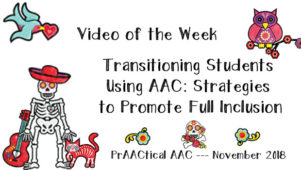
Transitions usually seem a bit daunting, but the move from the school system to post-school life is one fraught with a great many challenges. For people who use AAC, a group with unemployment rates exceeding 90%, the path to a rich and fulfilling life in adulthood requires a great deal of support. In many cases, the systems and individuals who are in the position to provide that support lack the information, experience, training, and resources they need to be effective. In today’s video, we hear from Dr. Rackensperger, Vice President for Persons who Use AAC and Their Families at USSAAC, who has a unique perspective on these issues. She shares ways that we can address these challenges by using person-based panning and strengths-based approaches in our efforts to foster self-determination and build self-advocacy. This video is part of the USSAAC webinar series and is made possible with the support of... [Read More...]
November 26, 2018
by Carole Zangari -
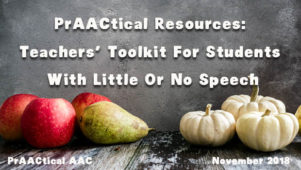
Looking for resources that promote successful school experiences? Need tools that support inclusive educational practices? Developed by Communication Rights Australia, the Teachers’ Toolkit for Students with Little or No Speech is a website that school personnel can use to identify effective strategies and supports for students with complex communication needs. Their Teachers’ Checklist contains a series of questions that are linked to topics on a range of supports and strategies that can make a big difference in the lives of AAC learners. There are also helpful forms for teams to develop a Student Profile and Individual Learning Plan. You can begin to explore their AAC resources here.
November 21, 2018
by Carole Zangari -
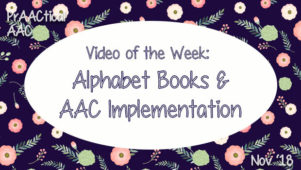
Today, we continue to learn from the AAC in the Cloud conference, hosted by CoughDrop AAC which organizes and runs this wonderful professional development event each spring as a service to the AAC community. In this post, former teacher and veteran AT and Education Consultant veteran Kelly Fonner gives us a variety of suggestions for creating and using alphabet books to build language and literacy skills in AAC learners. We are grateful for CoughDrop’s generosity is organizing their annual AAC in the Cloud Conference and offering it for free so that so many parents and professionals can advance their knowledge. Kelly’s engaging style and top-notch content in this session are not to be missed. Enjoy! You can obtain the handout for this session here. Direct Link to Video: https://www.youtube.com/watch?v=QTAfiW-pMKw
November 14, 2018
by Carole Zangari -
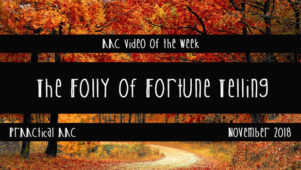
As AAC practitioners, we sometimes lose sight of how our prognostications impact the individuals we serve. In today’s featured video Rob Rummel-Hudson provides some perspective on this important issue. Many thanks to Mr. Rummel-Hudson, the AAC RERC, and the AAC team at Penn State for making this video available. Direct Link to Video – https://aac-learning-center.psu.edu/2018/10/14/the-folly-of-fortune-telling/
November 8, 2018
by Carole Zangari -
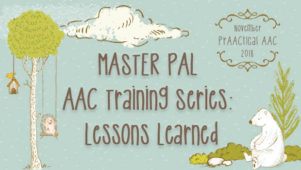
Thanks to all who reached out to express appreciation for Tabi Jones-Wohleber’s training resources in the MASTER PAL series. Many of you have already used the slides, video links, handouts, and discussion points that were shared over the past few months, and others have plans to do so. In this final post, Tabi shares some of the ‘lessons learned’ in creating and utilizing these materials. If you’re new to the series, you can check out each of the 11 modules here. ::::::::::::::::::::::::::::::::::::::::::::::::::::::::::::::::::::::::::::::::::::::::::::::::::::::::::::::::::::::::::::::::::; Over the last 11 weeks, facilitation strategies for communication partners have been shared through the Model as a MASTER PAL series. Model as a MASTER PAL is a framework for supporting communication partners of those who use AAC that evolved in response to the need go beyond the imperative and always present conversations of “use core words” and “model AAC”. It started as a list of ideas to... [Read More...]
November 7, 2018
by Carole Zangari -
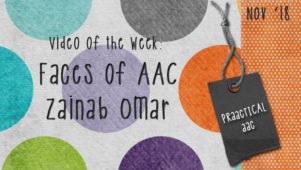
Hearing the AAC stories of people with complex communication needs is always enlightening, but even more so when the narratives are told directly by those individuals. In today’s featured video, we hear from South African teenager Zainab Omar. Enjoy! Many thanks to Zainab for sharing her story and to ISAAC for making this available to all of us. Please consider supporting this wonderful international organization (here’s how). Communication is everyone’s birthright. Direct Link to Video – https://www.youtube.com/watch?v=TrAe7oc-Rjo
November 5, 2018
by Carole Zangari -
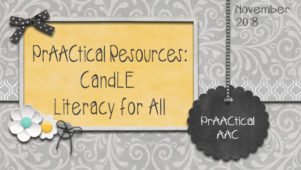
Looking for literacy resources to help in your teaching of individuals with AAC needs? Today, we travel to the UK to learn from the team at Communication and Learning Enterprises (CandLE). Their Literacy for All program has been in development for over 15 years and is broken down into 6 elements: Communication Emergent literacy Literacy needs assessment Conventional literacy Thinking skills Mainstream curriculum support On the site, they detail their process for each of these elements and give implementation tips and examples. For those who are interested, they also link to a companion site where their literacy resources are sold. You can explore their site here.
November 1, 2018
by Carole Zangari -
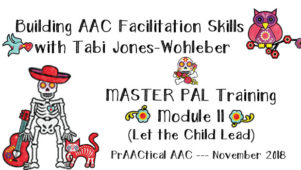
Today, Tabi Jones-Wohleber shares the last module in the MASTER PAL training series, which provides tips and strategies for working with children who don’t yet demonstrate joint attention. This module should take 30-40 minutes to present. Join us next week as we do a final wrap-up with suggestions on using this training series in your AAC work. ::::::::::::::::::::::::::::::::::::::::::::::::::::::::::::::::::::::::::::::::::::::::::::::::::::::::::::::: Model as a MASTER PAL Module 11: Let the Child Lead Facilitator Guidelines It can be really difficult to get communication started with a child who does not demonstrate joint attention. This module explores tips and strategies for traveling with a child on their journey from preoccupation with seeking sensory input/inattention to learning, engaging, and communicating. Because learning emerges from meaningful social emotional experiences, letting the child lead can go a long way toward being invited into their world. Then learning can happen! Here are some things you will need for this... [Read More...]
October 31, 2018
by Carole Zangari -
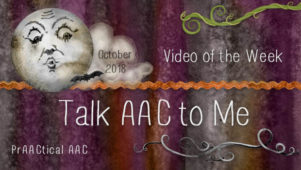
Sometimes the internet brings unexpected smiles. When this one crossed my inbox, it was too good not to share. Enjoy! Direct Link to Video – https://www.youtube.com/watch?v=HAl6zZXyHUg&app=desktop
October 29, 2018
by Carole Zangari -
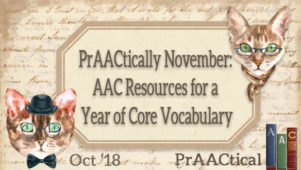
It’s just about time to turn another page on the calendar, and that means we’re busy preparing materials and activities for our November core words. Are you looking for some ways to help your AAC learners become more competent in using core words? Need to get staff on board with modeling core vocabulary? Trying to get familiar with where core words are stored in a particular SGD or AAC app? Here’s an approach you may want to try: Choose a dozen or so core words to focus on each month. In previous years, we shared lists of some core words to help you do just that. Set 1: A Year of Core (12 words/month) Set 2: A(nother) Year of Core (16 words/month; Note: These are different than the core words covered in 2013) Those posts have links to downloadable grids with the core words for each month that can be used as... [Read More...]









